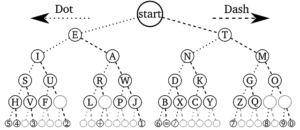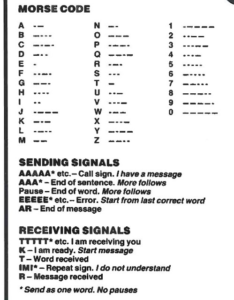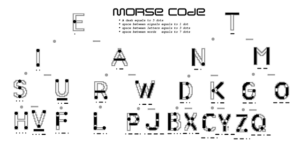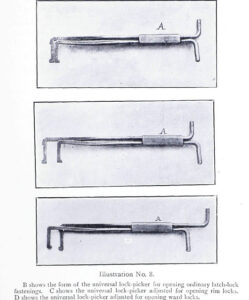Version 1.3
Some time ago there was a knock on my door.
A female student accompanied by a member of staff.
The young lady had locked her keys in her locker.
Could I do something?
Ironically, I had been having a sneaky read of some lock picking ebooks when I was disturbed.
I have access to three sets of bolt cutters in that building, but the issue was not could I do something, but should I?
I pointed out that I could not open a locker unless I had proof it was her locker.
Who had allocated her the locker?
The answer was the person who would have been my first port of call for the bolt-cutters.
I pointed out that he may not be in his room, selfishly enjoying his well-earned lunch break.
Dully, the student muttered something about could I give her a clip to open the lock with.
“Do you mean a paper clip?”
Bovine grunt to the affirmative.
Ironically I have just about everything in that room except decent springy paperclips!
“You can’t pick a lock with a clip. You need a tension tool too” I told her.
One might think, given that this is supposedly a future scientist, that “What is a tension tool?” might have been a likely response, with possibly, “Do you have a tension tool?” or “How do I get a tension tool?”
A further grunt about clips and she wandered off with the member of staff to find a paperclip.
I have no idea how much time she wasted trying to pick the lock without a tensioner.
Picking is all about the correct application of tension.
It doesn’t matter if you are single-pin picking, raking, using a pick gun or an electric pick; you still need a tension tool.
One of the most common mistakes about picking that you see in the movies is a character using a pick or pick gun and no tension tool. This is like a horse-riding scene without the horse.
Admittedly, tension tools are the less glamorous half of the double act.
In many kits you get dozens of varied pick designs but just a couple of tension tools, almost like they are thrown in as an afterthought.
Picks show considerable variety, while tension tools often seem to be bent bits of metal, often home-made.
As you become more experienced, you begin to appreciate that the tensioner and how you apply it is critical in whether a lock opens easily or not at all.
The proportion of tensioners to picks in your kit may begin to shift, particularly when you realise you only use a small proportion of your available picks for most tasks.
Tension tools are commonly called “tension wrenches”, although some pickers object to the term “wrench”.
It can also be argued that what pickers call “tension” is more strictly “torque”, so the term “turning tool” is used as well. That said, web-searching “tension wrench” will give you more hits relevant to lock picking than “torque wrench”.
Trying to acquire more tension tools can be frustrating!
Some companies will only sell you turning tools as part of a larger set or with a pick kit.
When you can buy individual items, many companies do not bother to list the width and thickness of the tools.
Also. crossing the Atlantic tends to at least double the price!
Not surprisingly, many pickers tend to “roll their own”.
Turning tools are easy to make or modify. Tolerances are broad and tools are not subjected to strong forces.
BosnianBill’s article on tension tools provides some useful photos of tools alongside steel rules. Another useful page for dimensions and design features may be found on this page.
Red: .030" thick .50" leg, .125" wide and 3" long; .25" leg, .094" wide and 3" long.
White: .040" thick .50" leg, .125" wide and 3" long; .25" leg, .094" wide and 3" long.
Blue: .050" thick .50" leg, .125" wide and 3" long; .25" leg, .094" wide and 3" long.
Finding materials to make your own tools can be problematic.
The “steel wiper blade inserts” usually recommended are not as easy to find in some areas as others.
You take pot luck at what you can find, and as was seen in my account here, thicknesses of material can be significant.
It would be nice if more retailers sold raw materials for making tools.
There are other options. Some pickers make tension tools by bending the tips of screwdrivers.
TOK and BOK
You will encounter the terminology TOK and BOK.
American locks are usually mounted pins upwards, so turning tools that are applied to the pin side of a keyway have become known as “top of keyway” (TOK) tools and the alternative “bottom of keyway” (BOK).
In Europe, it is common for locks to be mounted either way up, so these terms can be a little confusing.
TOK is often used as a term for prybar-type turning tools and BOK for other tools.
In reality, some prybars may be applied to the bottom/outside of a keyway and a narrow headed BOK tool might be used on the top/inner side of a keyway.
TOK tools tend to be used at the 12 and 6 o’clock positions, BOK at more oblique angles.
Alternate terminology is “centre of plug” and “edge of plug”.
Typical “L-shaped” “BOK” turning tools (above).
The two on the left are both 3mm/0.12" wide, which could be considered to be the standard width.
The longer one has a twist handle and is from a set of five tools that is widely available on ebay. They take ages to come but cost very little and were surprisingly nicely finished.
Their price makes them a good source of materials for customization or creating your own tools.
The shorter tool is from my Serenity kit and is probably the tensioner that I use the most. I plan to bend the end into another, narrower head.
Generally, turning tools are used with very light pressure, so do not need to be very long.
A tool such as the longer one above could easily be cut and made into an additional tool.
I will keep this tool as it is just in case I ever need a long tool. It could easily be bent into a shape that can be used on a tulip lock, for example.
Keyways are very useful for bending and improvising tools.
Second from the right is one of the tools supplied with my larger Chinese pick set. It is narrower and noticeably thinner than the two to the left but still useful.
It could also be cut to make a second tool or bent to make a Z-tool.
Rightmost tool (above and next below) is made from a pen clip. Unusual in that it required some unbending rather than bending. The shoulders and head could be filed down if desired, and the other end could also be made into a head for a Z-tool. This nicely illustrates that a turning tool need not be that long.
Update: I have since seen it suggested that longer turning tools provide greater feedback, which is logical.

Tulip turning tools are used for locks recessed into doorknobs. This is obviously an application where length has advantages.
This article notes that the same effect can be more simply be achieved by creating a tool with a sixty-degree bend.
The handles of many Bogota picks are already at sixty degrees.
Two home-made Z-tools (above).
The one on the left is made from a laboratory spatula. This was intended as a wide turning tool so was left at its original 4 mm width. It could easily be filed down to standard or narrow width.
The keyway of a padlock was used to bend the ends.
The next tool from the left was made from a windscreen wiper insert and was seen in my article here.
The short end has been filed down to about 2 mm and the shank and shoulders suitably filed and tapered (shown below).
The shorter end is used in small locks but can also be used TOK. The end of the shorter nose will be filed square for more effective use TOK.
The result is a versatile tool that can be constructed in just a few minutes.
Ideally I would have a set of these in different thicknesses, complimented by the larger tool.
The middle tool is the standard-width tool from my larger Chinese kit.
Next to it is another tool made from a pen clip, but not yet filed to final dimensions.
The rightmost tool is the same design as that which comes in the Goso hook kit, and one of the most useful parts of that kit.
This tool also comes with the five-part tension tool kit I mentioned earlier.

Flat Z-tools (above).
These three on the left came with the five-part tension tool kit.
Unlike many Chinese-made picks, the turning tools are competently finished and seem serviceable. One is thicker than the other two.
I don’t use these a lot but they work well enough and I have even had some TOK successes with them!
It is a shape worth bearing in mind if you are improvising turning tools. Such turning tools are often associated with picking dimple locks.
On the far right is the prybar tool from my Serenity kit.
Prybar and TOK tensioners are favoured by many pickers who are far more experienced than myself.
TOK gives more room for hooks and probes to move when single pin picking (SPP). BOK allows a rake to make better contact with the pins.
I find I have trouble with them popping out of locks.
Prybars are often used for picking with TOK, which I often cannot get to work, perhaps because I usually rake locks.
Part of the problem may be the Serenity prybar appears to be under 1 mm thick, probably 0.8 mm, so not suited to some of the wider keyways I have on some locks. This prybar works with my narrow SKS lock.
Ideally you also want prybars made from 1mm/0.04" or 1.2mm/0.05" thick material.
Many retailers do not bother to list the thickness of prybars, so you may encounter thinner examples.
Y-shaped turning tools are used for certain styles of car lockway. Many of these locks have shutters and wafers on either side.
This type of turner are sometimes called “wishbone” tools.
Lock picking is generally about “less force, more finesse”.
If it is not working the solution is usually a gentler touch on the pick, rake or tensioner.
Spring tensioners reduce the tendency to apply too much torque.
By the time I tried using a spring tool I had already developed the habit of a light touch and had to use more pressure on it than I was accustomed to!
Springs seem to work but you should learn to use more conventional tensioners if you are to be proficient with improvised devices.
My experience with turning tools made from hairpins has been mixed.
The best results have been with tools constructed to be at a vertical angle to the lock, like a prybar. Bend the end over so it acts as a wider, flatter beak that cannot turn.
Wider keyways will need additional modification.
You will probably find hairpins too wide to be used as picks on some locks.











































